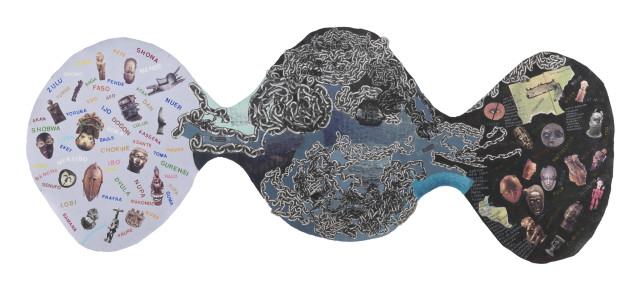
Howardena Pindell
Slavery Memorial: Lash, 1998-1999
Mixed media on canvas
141 x 345.4 cm
55 1/2 x 136 in
55 1/2 x 136 in
Working across figuration, abstraction and conceptualism, Howardena Pindell has since the 1970s examined a wide range of subject matter, from the abstract and mathematical, to the personal and diaristic, to the social and political. Hers is a complex and nuanced body of work, a fusion of sensuality and intellectual enquiry in which texture, colour, structure and process are employed to mine history (and hidden histories) and to address intersecting issues such as racism, violence and exploitation.
Pindell’s practice became more overtly political and autobiographical in the 1980s, following a car accident in 1979 which left her with short-term memory loss. The artist has spoken of the impact of this event on her work, where elements of abstraction and figuration were cut apart and stitched together, almost as an act of remembering, an attempt to ‘mend the rupture’ brought about by concussion. Throughout the ensuing decade, Pindell largely abandoned the rectangle – opting for irregular, often ovoid canvases, some cut in pieces and sewn back together – and began integrating representational elements and text.
Completed in 1998–1999, Slavery Memorial: Lash, makes use of the forms and techniques that are hallmarks of Pindell’s work from this period. Its three circular sections provide a dynamic visual flow for the work’s content and message. The left-hand section contains names of tribes and nations in Africa that exist today. The masks scattered in this section are derived from those tribes.
The central section represents the Middle Passage. Criss-crossed by chains it immediately suggests bondage and the torturous voyage during which Africans, densely packed on to ships, were transported across the Atlantic to the Americas. Hidden among the chains are skulls representing slaves who were thrown overboard for being unruly or ill. Additionally, some of the chains bear the names of countries involved in the slave trade. There are also names of slave ships on some chains and some diagrammatic images of slave ships scattered throughout. A turquoise section amongst the chains represents the Caribbean, where the enslaved were taken to work in the sugar cane fields.
Prominent in the right-hand section are the names of black inventors (see accompanying document). Relatives of former slaves, these men and women are responsible for hundreds of inventions large and small, including a portable basin (Haines), an air-purification device (Stokes), a dough kneader (Bell), a sail control (Forten) and a propeller for vessels (Toliver). In addition, the right-hand section bears masks and the names of US cities and states involved in the slave trade.
Of the work’s personal significance, Pindell writes:
‘Lash is a memorial for my great, great aunt on my father’s side. She was enslaved and was blinded in one eye by the slave “master’s” whip. She died in her 90s although the family rumour was that she lived to be 113. On the right side of the work is an eye with a slash across it representing my relative being blinded by a slave owner’s whip.
If you rotate the painting to a vertical position, the shape represents the format of the DNA. My DNA is complex, I believe, because of the massive amount of rape during slavery as well as my deep ancestry that goes back on my mother’s side 80,000 years in Africa. (National Geographic Genome Project).
My African DNA includes: Zulu, Bantu, Nigeria, Benin, Madagascar, Ethiopia, Libya, Uganda. Some of my European DNA includes: Scandinavia, Germany, Ireland, Spain, Basque, Portugal, Finland, Sicily, Cyprus. In addition, my DNA includes the Bahamas, Palestine, Alaskan Inuit, India, as well as Ashkenazi and Sephardi.’
Provenance
The artistExhibitions
Howardena Pindell: A New Language, Fruitmarket, Edinburgh, Scotland, 13 November 2021 – 2 May 2022
Howardena Pindell: Rope/Fire/Water, The Shed, New York, USA, October 16, 2020 - April 11, 2021
Rock My Soul, curated by Isaac Julien, Victoria Miro, London, UK, October 2 - November 2, 2019
Howardena Pindell: In My Lifetime, G.R. N’Namdi Gallery, New York, USA, June 3 - August 31, 2006
Witness to Our Time: A Decade of Work by Howardena Pindell, Heckscher Museum of Art, Huntington, New York, USA, April 24 - August 8, 1999
Publications
Howardena Pindell: A New Language, exh. cat. (Fruitmarket, Edinburgh, Scotland 2021 - 2022) illustrated pp. 84-85